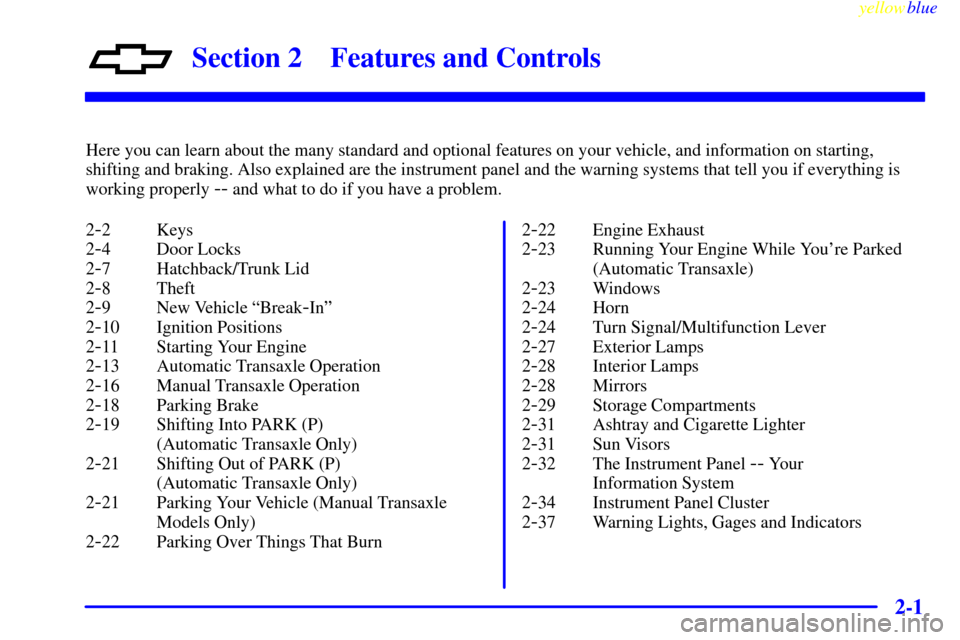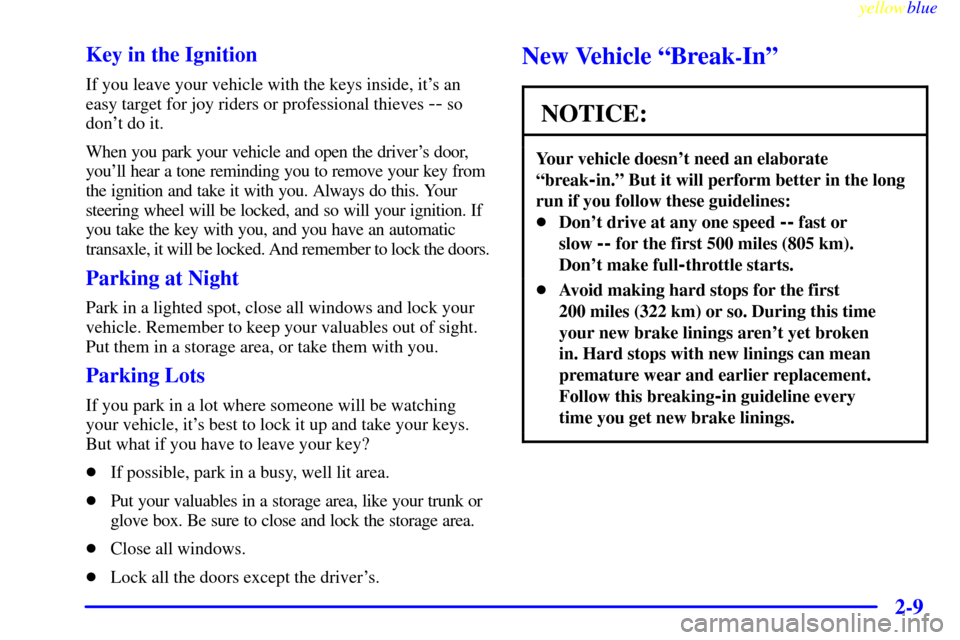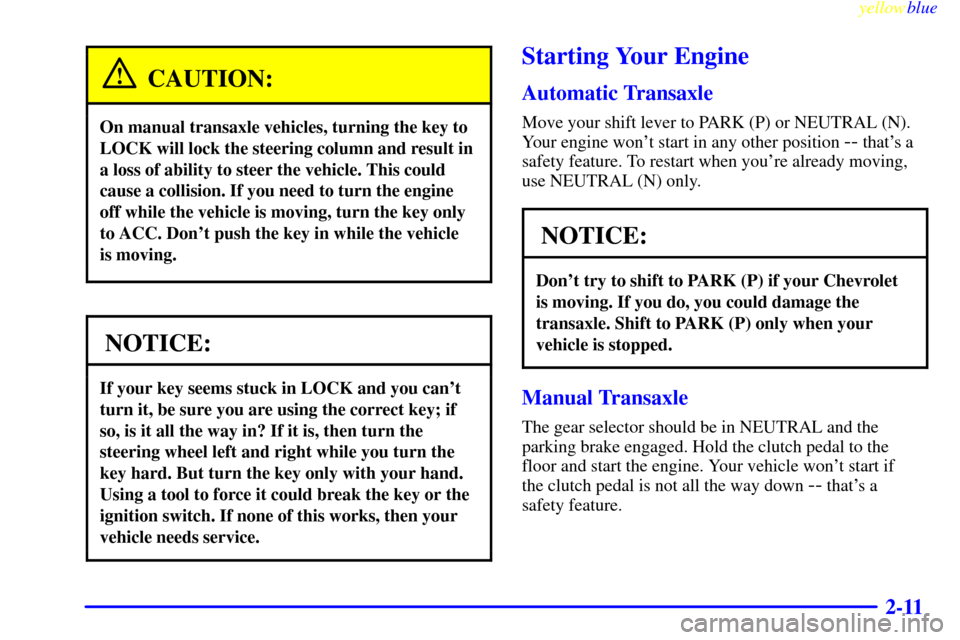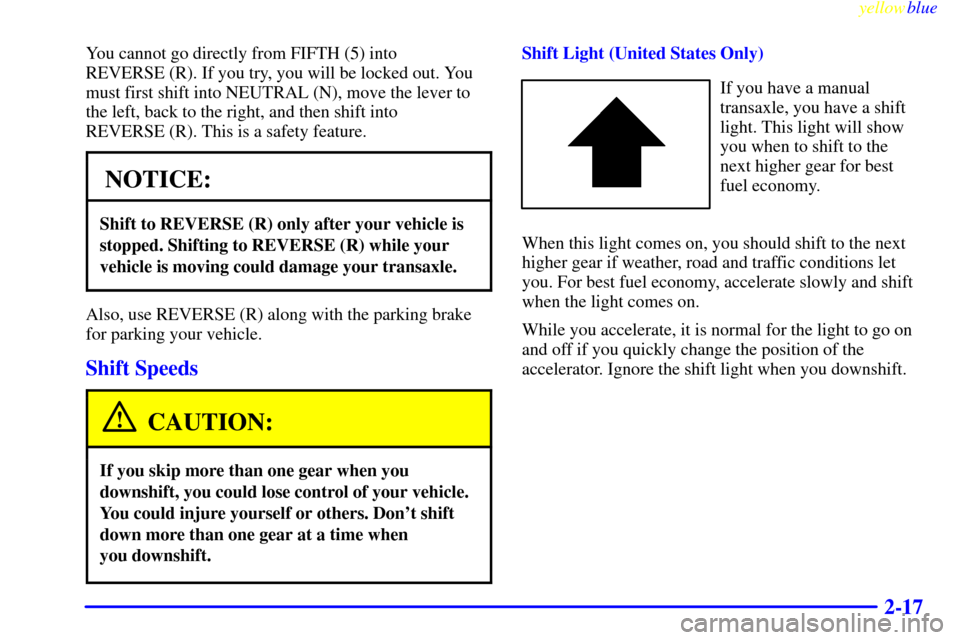Page 8 of 328
yellowblue
viii
For example,
these symbols
are used on an
original battery:
CAUTION
POSSIBLE
INJURY
PROTECT
EYES BY
SHIELDING
CAUSTIC
BATTERY
ACID COULD
CAUSE
BURNS
AVOID
SPARKS OR
FLAMES
SPARK OR
FLAME
COULD
EXPLODE
BATTERY
These symbols
are important
for you and
your passengers
whenever your
vehicle is
driven:
DOOR LOCK
UNLOCK
FASTEN
SEAT
BELTS
POWER
WINDOW
AIR BAG
These symbols
have to do with
your lamps:
MASTER
LIGHTING
SWITCH
TURN
SIGNALS
PARKING
LAMPS
HAZARD
WARNING
FLASHER
DAYTIME
RUNNING
LAMPS
FOG LAMPS
These symbols
are on some of
your controls:
WINDSHIELD
WIPER
WINDSHIELD
WASHER
WINDSHIELD
DEFROSTER
REAR
WINDOW
DEFOGGER
VENTILATING
FAN
These symbols
are used on
warning and
indicator lights:
ENGINE
COOLANT
TEMP
BATTERY
CHARGING
SYSTEM
BRAKE
COOLANT
ENGINE OIL
PRESSURE
ANTI-LOCK
BRAKES
Here are some
other symbols
you may see:
FUSE
LIGHTER
HORN
SPEAKER
FUEL
Vehicle Symbols
These are some of the symbols you may find on your vehicle.
Page 59 of 328

2-
yellowblue
2-1
Section 2 Features and Controls
Here you can learn about the many standard and optional features on your vehicle, and information on starting,
shifting and braking. Also explained are the instrument panel and the warning systems that tell you if everything is
working properly
-- and what to do if you have a problem.
2
-2 Keys
2
-4 Door Locks
2
-7 Hatchback/Trunk Lid
2
-8 Theft
2
-9 New Vehicle ªBreak-Inº
2
-10 Ignition Positions
2
-11 Starting Your Engine
2
-13 Automatic Transaxle Operation
2
-16 Manual Transaxle Operation
2
-18 Parking Brake
2
-19 Shifting Into PARK (P)
(Automatic Transaxle Only)
2
-21 Shifting Out of PARK (P)
(Automatic Transaxle Only)
2
-21 Parking Your Vehicle (Manual Transaxle
Models Only)
2
-22 Parking Over Things That Burn2
-22 Engine Exhaust
2
-23 Running Your Engine While You're Parked
(Automatic Transaxle)
2
-23 Windows
2
-24 Horn
2
-24 Turn Signal/Multifunction Lever
2
-27 Exterior Lamps
2
-28 Interior Lamps
2
-28 Mirrors
2
-29 Storage Compartments
2
-31 Ashtray and Cigarette Lighter
2
-31 Sun Visors
2
-32 The Instrument Panel -- Your
Information System
2
-34 Instrument Panel Cluster
2
-37 Warning Lights, Gages and Indicators
Page 67 of 328

yellowblue
2-9 Key in the Ignition
If you leave your vehicle with the keys inside, it's an
easy target for joy riders or professional thieves
-- so
don't do it.
When you park your vehicle and open the driver's door,
you'll hear a tone reminding you to remove your key from
the ignition and take it with you. Always do this. Your
steering wheel will be locked, and so will your ignition. If
you take the key with you, and you have an automatic
transaxle, it will be locked. And remember to lock the doors.
Parking at Night
Park in a lighted spot, close all windows and lock your
vehicle. Remember to keep your valuables out of sight.
Put them in a storage area, or take them with you.
Parking Lots
If you park in a lot where someone will be watching
your vehicle, it's best to lock it up and take your keys.
But what if you have to leave your key?
�If possible, park in a busy, well lit area.
�Put your valuables in a storage area, like your trunk or
glove box. Be sure to close and lock the storage area.
�Close all windows.
�Lock all the doors except the driver's.
New Vehicle ªBreak-Inº
NOTICE:
Your vehicle doesn't need an elaborate
ªbreak
-in.º But it will perform better in the long
run if you follow these guidelines:
�Don't drive at any one speed
-- fast or
slow
-- for the first 500 miles (805 km).
Don't make full
-throttle starts.
�Avoid making hard stops for the first
200 miles (322 km) or so. During this time
your new brake linings aren't yet broken
in. Hard stops with new linings can mean
premature wear and earlier replacement.
Follow this breaking
-in guideline every
time you get new brake linings.
Page 69 of 328

yellowblue
2-11
CAUTION:
On manual transaxle vehicles, turning the key to
LOCK will lock the steering column and result in
a loss of ability to steer the vehicle. This could
cause a collision. If you need to turn the engine
off while the vehicle is moving, turn the key only
to ACC. Don't push the key in while the vehicle
is moving.
NOTICE:
If your key seems stuck in LOCK and you can't
turn it, be sure you are using the correct key; if
so, is it all the way in? If it is, then turn the
steering wheel left and right while you turn the
key hard. But turn the key only with your hand.
Using a tool to force it could break the key or the
ignition switch. If none of this works, then your
vehicle needs service.
Starting Your Engine
Automatic Transaxle
Move your shift lever to PARK (P) or NEUTRAL (N).
Your engine won't start in any other position
-- that's a
safety feature. To restart when you're already moving,
use NEUTRAL (N) only.
NOTICE:
Don't try to shift to PARK (P) if your Chevrolet
is moving. If you do, you could damage the
transaxle. Shift to PARK (P) only when your
vehicle is stopped.
Manual Transaxle
The gear selector should be in NEUTRAL and the
parking brake engaged. Hold the clutch pedal to the
floor and start the engine. Your vehicle won't start if
the clutch pedal is not all the way down
-- that's a
safety feature.
Page 71 of 328
yellowblue
2-13
Automatic Transaxle Operation
There are several different positions for your shift lever.
PARK (P): This locks your front wheels. It's the best
position to use when you start your engine because your
vehicle can't move easily.
CAUTION:
It is dangerous to get out of your vehicle if the
shift lever is not fully in PARK (P) with the
parking brake firmly set. Your vehicle can roll.
Don't leave your vehicle when the engine is
running unless you have to. If you have left the
engine running, the vehicle can move suddenly.
You or others could be injured. To be sure your
vehicle won't move, even when you're on fairly
level ground, always set your parking brake and
move the shift lever to PARK (P).
See ªShifting Into PARK (P)º in the Index.
Page 75 of 328

yellowblue
2-17
You cannot go directly from FIFTH (5) into
REVERSE (R). If you try, you will be locked out. You
must first shift into NEUTRAL (N), move the lever to
the left, back to the right, and then shift into
REVERSE (R). This is a safety feature.
NOTICE:
Shift to REVERSE (R) only after your vehicle is
stopped. Shifting to REVERSE (R) while your
vehicle is moving could damage your transaxle.
Also, use REVERSE (R) along with the parking brake
for parking your vehicle.
Shift Speeds
CAUTION:
If you skip more than one gear when you
downshift, you could lose control of your vehicle.
You could injure yourself or others. Don't shift
down more than one gear at a time when
you downshift.
Shift Light (United States Only)
If you have a manual
transaxle, you have a shift
light. This light will show
you when to shift to the
next higher gear for best
fuel economy.
When this light comes on, you should shift to the next
higher gear if weather, road and traffic conditions let
you. For best fuel economy, accelerate slowly and shift
when the light comes on.
While you accelerate, it is normal for the light to go on
and off if you quickly change the position of the
accelerator. Ignore the shift light when you downshift.
Page 76 of 328
yellowblue
2-18
Parking Brake
The parking brake is located between the seats. To set
the parking brake, hold the brake pedal down and pull
up on the parking brake lever. If the ignition is on, the
brake system warning light will come on.
To release the parking brake, hold the brake pedal down.
Pull the parking brake lever up until you can press the
release button. Hold the release button in as you move
the lever all the way down.
NOTICE:
Driving with the parking brake on can cause
your rear brakes to overheat. You may have to
replace them, and you could also damage other
parts of your vehicle.
Page 77 of 328
yellowblue
2-19
Shifting Into PARK (P)
(Automatic Transaxle Only)
CAUTION:
It can be dangerous to get out of your vehicle if
the shift lever is not fully in PARK (P) with the
parking brake firmly set. Your vehicle can roll. If
you have left the engine running, the vehicle can
move suddenly. You or others could be injured.
To be sure your vehicle won't move, even when
you're on fairly level ground, use the steps
that follow.
1. Hold the brake pedal down with your right foot and
set the parking brake.
2. Move the shift lever into PARK (P) by holding in the
button on the lever and pushing the lever all the way
toward the front of your vehicle.
3. Turn the ignition key to LOCK.
4. Remove the key and take it with you. If you can
leave your vehicle with the ignition key in your
hand, your vehicle is in PARK (P).